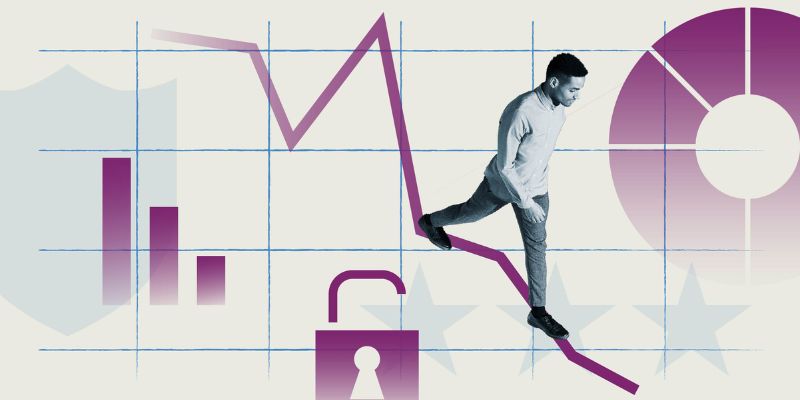Investors often ask me, “How do economic indicators affect the stock market?” Your portfolio’s health is tied to these signals. They’re like the market’s pulse. High GDP growth can shoot stock prices up, while high inflation might drag them down. Consumer confidence tells us if people will spend, and unemployment data signals economic stress. Knowing these indicators helps you predict where stocks might go. Ready to make sense of these numbers? Let’s dive in.
How Economic Indicators Predict Stock Market Movements: A Trader’s Guide
Understanding GDP Growth Influence and Inflation Rates Impact
Let’s dive into two big signs of the times: GDP growth and inflation rates. GDP, or Gross Domestic Product, tells us how well a country’s economy is doing. Think of it as a huge report card for a country’s economy. When this number is up, it means businesses are buzzing, people are working, and money is flowing. What does this mean for stocks? Usually, good news. As GDP grows, so do profits and stock prices.
Inflation, on the other hand, is like the cost of living’s speedometer. When inflation races ahead, your money buys less. It’s a bit tricky for stocks. Low inflation is great as it keeps costs down for companies, and stable prices are good for us all. But if it ticks up too much, it can scare folks. The cost of goods climbs, squeezing profits. If those profits fall, so can stock prices. It’s about finding the sweet spot.
Now for a quick rundown on these two. When GDP is on the up, stocks often follow. When inflation is calm, it’s all good. But watch out when it jumps – stocks may dip as investors worry about costs and spending power.
Analyzing Consumer Confidence Index and Unemployment Data
Let’s chat about folks like you and me—consumers. The Consumer Confidence Index is like taking the temperature of how we all feel about the economy. Are we ready to spend on big things like cars and homes? If this number is high, we’re feeling good, and we’re opening our wallets. This means more sales and higher stock prices for companies. So, high confidence? It’s a thumbs-up for stocks.
Unemployment data is also key. If many people are out of work, they’re not spending money. Less spending can mean tough times for businesses and lower stock values. But when jobs are plenty and unemployment is low, it’s party time. People have more cash to splash, businesses thrive, and stock prices can soar.
Quick lesson: high consumer confidence can pump up stock prices. Low unemployment can mean people spend more, which can push stock prices higher, too.
Understanding these signs is like having a secret code. It allows us to see what might happen in the stock market. Remember, no one can predict it perfectly, but these clues are solid gold in making your best guess.

Interpreting Central Bank Decisions: The Role of the Federal Reserve and Interest Rates
How Interest Rates Effect Stock Market Volatility
When the Federal Reserve changes interest rates, stocks feel it. Think of interest rates as the price of money. If this price goes up, borrowing costs more. Companies may slow down on spending and borrowing. This can lower their profits. When profits fall, investors may sell their stocks. This selling can make stock prices drop fast. That’s how higher interest rates cause more ups and downs in the stock market.
In simple words, low interest rates make money cheap. This encourages people and businesses to borrow and spend. More spending can boost company profits. As profits climb, so can stock prices. This can make the market steadier.
Investor Sentiment and Monetary Policy Implications
Investors watch what the Federal Reserve does closely. The Fed’s decisions give clues about the economy’s health. When the Fed raises rates, investors may think the economy is too hot. They might worry about high inflation. Such worries can make investors careful. They might sell risky stocks and buy safer things, like bonds.
If the Fed cuts rates, it’s often trying to help a slow economy. Lower rates can make investors happy. They might buy more stocks, hoping the economy will grow. This demand can push stock prices up.
But remember, the Fed’s moves take time to work through the economy. So, a rate change today might not affect stocks until months later.
The Fed’s words matter too. When they talk about what they might do next, investors listen. They try to guess what will happen. This guessing can make stock prices swing before the Fed even acts.
Understanding the Fed’s role helps us see why stock prices move. It’s like reading weather patterns to predict storms. We can’t say exactly when or where a storm will hit. But we can get ready and know what to watch for.
Fed decisions and interest rates are big pieces of this puzzle. They help us guess where the stock market could go next. Keep an eye on them, and you’ll get better at seeing what might happen to your stocks.

Beyond Traditional Data: The Significance of Retail Sales, Manufacturing, and Housing Statistics
Commodities, Durable Goods, and the Influence of Retail Sales Data
Let’s talk shop, trade style. When people buy more stuff, it means they feel good about money. This buying info is called retail sales data. It’s a way to check the health of the economy. Retail sales show us if folks are opening their wallets or keeping them shut tight. When sales are up, factory wheels keep turning, producing more goods like fridges and cars. We call these products durable goods because they last a long time.
Retail sales data can move stock prices. Imagine you invest in a company that sells lots of clothes. If the retail sales report is sunny, people might be shopping more. Good news – the stock price might jump because the company could sell more clothes. But, if the retail sales storm clouds roll in, folks might be buying less. Not so good – the stock price could take a dip.
Housing Market Statistics and Manufacturing Data Relevance
Now, let’s build on that idea. Housing is a big deal in the economy. It tells us about jobs, banks giving loans, and how much cash folks have for a new pad. When people are buying homes, it’s like a thumbs-up for the economy. Companies that make building stuff and home goods can see their stocks go up, up, up.
But there’s more – digs like factories and machines also matter. This is called manufacturing data. It’s like taking the economy’s temperature. Strong factory data means workers are busy bees and the economy’s buzzing. But if it’s looking weak, stocks might shake like a leaf because it can mean trouble ahead for jobs and spending.
So, as a trader, keep an eye on all these signs. Retail sales, housing info, and how factories are doing. They can give you a heads-up on what might come next for stocks. Plus, they help you get why markets do the twist and turns they do. It’s all about knowing the play before it happens, and that’s the real win.
Understanding these pieces of the game helps us all. So next time you hear about housing starts or retail sales, think about what it could mean for your stocks. And remember, money talks in many ways – we just have to listen.

Forecasting Market Movements: Using Leading and Lagging Economic Indicators
Predictive Power of Leading Economic Indicators on Market Predictions
Let’s talk about clues to where stocks might go. Think of leading indicators as hints. They hint at what might happen to stocks in the future. Now, how do they do that? These clues include stuff like new orders that factories get, what people are building, or how confident businesses feel. They change before the bigger economy does. So, if more things get made or more buildings go up, stocks usually go up too.
For instance, if a lot of folks are buying stuff and orders for goods are up, that means factories are busy. Good news, right? Stocks tend to like that, going higher. So we watch these leading guys closely. They help traders bet on the stock market’s next move. It’s kind of like guessing who will win a race based on the fastest practice laps.
Leading indicators also factor in job numbers. Lots of jobs mean people have more money to spend. This can push stocks higher. Then there’s the big daddy of them all, the purchasing managers’ index or PMI. It tells us what the bosses who buy stuff for companies think about the economy. If they’re happy and buying a lot, stocks often jump for joy too.
Lagging Indicators and Their Impact on Stock Market Trends
Now, what about those lagging indicators? Think of them like a look in the rearview mirror. They tell you what the economy already did. They’re tardy to the party – they follow the big changes in the economy. We talk about things that happen after big shifts like how much folks earn or how much the stuff we sell abroad beats the stuff we buy from other countries.
But hey, they’re still cool to know. Even though they look back, lagging indicators can confirm if a market is moving the way we thought. It’s like checking to see if the race’s final results match the practice runs. They’re cheeky like that, making sure what we saw before really did happen.
Plus, lagging indicators, like how much companies keep in stock, can warn us if trouble’s brewing. If shops are stuck with loads of unsold stuff, it could mean bad news for stock prices. No one wants to see old TVs pile up in a warehouse when everyone’s streaming on their phones, right?
In summary, leading indicators give us a sneak peek at where the market might be heading, while lagging indicators confirm the moves after they happen. Both are super key for savvy traders. By keeping an eye on these indicators, traders can make better guesses on where stocks will race to next. Remember though, this market is a tricky beast and surprises us often. So, we use all the clues – both leading and lagging – to try and outsmart it. It’s all part of the big, wild puzzle of trading stocks.
We’ve looked at how money signs shape the stock market. GDP growth and inflation tell us a lot. They show if an economy is strong or weak, and that moves stock prices. We learned that when people feel good about spending and jobs, stocks tend to go up. Unemployment data matters too.
We also talked about the Fed and interest rates. If rates go up, stocks might drop because loans cost more. The Fed’s choices affect how investors feel and what they do with their money.
We can’t forget retail and home sales, or what factories do. These give clues about where the economy’s going. When stores sell a lot, and homes are built, the market often does well.
Last, we saw that signs that predict changes are key for guessing market moves. But we have to watch the ones that follow changes too, to see the full picture.
In short, watching these signs helps us guess where the market’s headed. This can guide us when we decide to buy or sell stocks. Keep an eye on these signs to make smart moves in the stock market.

